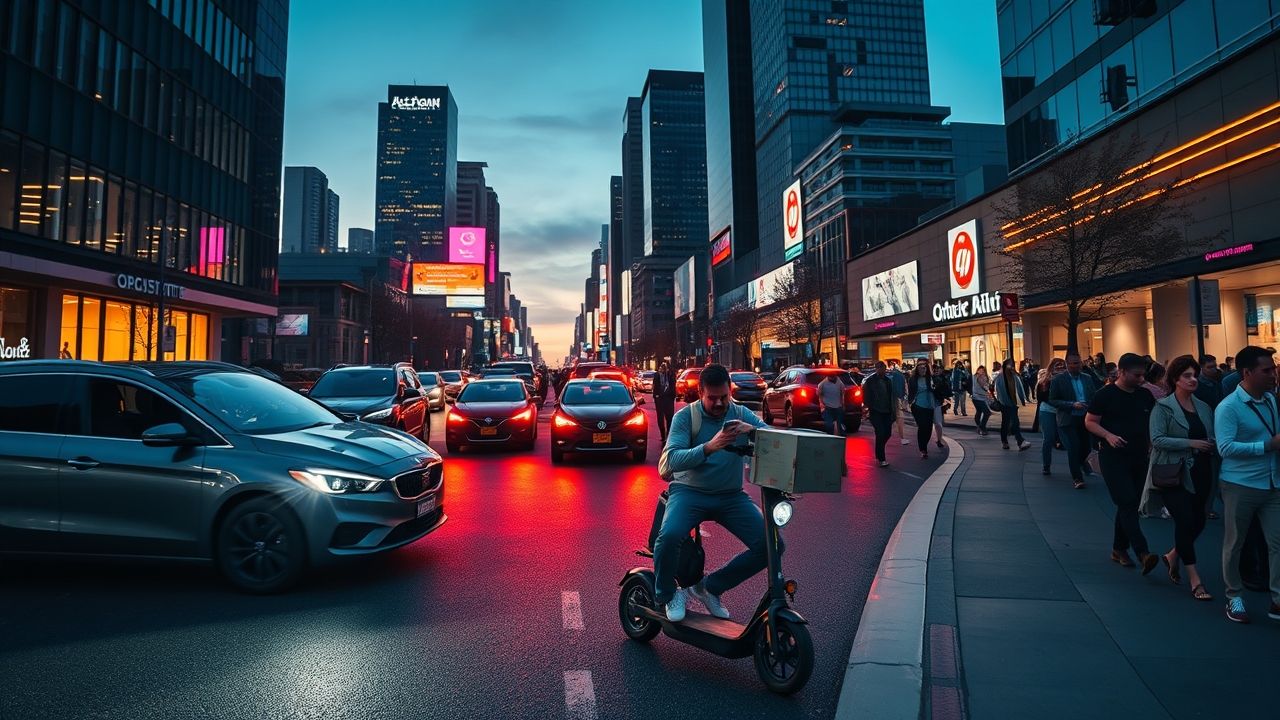Few companies have reshaped urban landscapes and daily routines quite like Uber. What began as a simple idea for premium ride services has blossomed into a global behemoth, fundamentally altering how we move, how we eat, and how millions earn a living. The story of Uber is one of relentless innovation, contentious labor debates, and a constant dance with regulatory bodies, creating a narrative that is as complex as it is compelling.
Key Summary
- Uber’s Evolution: Transformed from a luxury ride service into a multifaceted logistics and technology company.
- Gig Economy Pioneer: A central figure in the debate surrounding flexible work, driver classification, and worker benefits.
- Regulatory Challenges: Faces ongoing legal and governmental scrutiny across various markets regarding operations and labor practices.
- Diversified Services: Beyond ride-hailing, Uber Eats is a major player, with ventures into freight and autonomous technology.
- Future Impact: Continues to influence urban planning, transportation infrastructure, and the global workforce.
Why This Story Matters
The story of Uber isn’t just about a tech company; it’s a microcosm of the 21st-century economy. It touches on critical issues such as the future of work, the balance between innovation and regulation, consumer convenience versus worker rights, and the ethical implications of data-driven platforms. Understanding Uber is crucial to grasping the broader societal shifts underway, particularly in how technology mediates our interactions with services and labor. Its trajectory offers invaluable insights into the challenges and opportunities presented by the gig economy, the power of venture capital, and the public’s complex relationship with disruptive technologies.
The Rise of Uber: A Decade of Disruption
When Uber launched in 2009, few could have predicted its meteoric rise. Co-founded by Travis Kalanick and Garrett Camp, the company, originally “UberCab,” aimed to make black car services accessible via a mobile app. The premise was simple yet revolutionary: tap a button, and a car arrives. This convenience quickly resonated with users, leading to rapid expansion across major cities worldwide. The initial focus on luxury soon shifted to broader appeal with the introduction of UberX, offering more affordable rides and opening up a vast new market for both passengers and drivers. This move democratized transportation in an unprecedented way, challenging established taxi industries globally.
From Ride-Hailing to Global Logistics
Uber’s ambition quickly outgrew mere ride-hailing. Recognizing the vast infrastructure it had built—a network of drivers, a robust app, and sophisticated logistics algorithms—the company began to diversify. Uber Eats, launched in 2014, leveraged this existing network to enter the booming food delivery market, becoming a dominant force alongside its ride-sharing counterpart. This strategic expansion underscored a vision for Uber not just as a transport provider, but as a comprehensive platform for on-demand services, capable of moving people, food, and eventually, even freight. The underlying technology, constantly refined, optimized routes, managed payments, and connected millions of individuals, solidifying its position as a digital backbone for urban mobility and consumption.
Navigating the Gig Economy Landscape
At the heart of Uber’s model lies the gig economy, a system where temporary, flexible jobs are commonplace, and companies tend toward hiring independent contractors and freelancers instead of full-time employees. This model has been both Uber’s greatest strength and its most persistent challenge. It offered unparalleled flexibility to drivers, allowing them to set their own hours and work when it suited them. However, it also sparked heated debates about worker classification, minimum wage, benefits, and the lack of traditional employee protections. For many, Uber became the poster child for the gig economy’s pros and cons, igniting a global conversation about fair labor practices in the digital age.
Regulatory Roadblocks and Labor Battles
The innovative nature of Uber’s business model often placed it at odds with existing regulations designed for traditional taxi services. This led to a patchwork of legal battles, bans, and protests across countless cities and countries. From disputes over licensing and insurance to challenges regarding pricing structures and accessibility for people with disabilities, Uber’s journey has been marked by a constant negotiation with local authorities. This regulatory friction was a testament to the disruptive power of the platform, as governments grappled with how to integrate or control a service that didn’t fit neatly into pre-digital frameworks.
The Fight for Driver Rights
Perhaps no aspect of Uber’s history has been as contentious as the debate over driver status. Drivers, classified as independent contractors, typically lack benefits such as health insurance, paid sick leave, and minimum wage guarantees common for employees. This model, while providing flexibility, has been fiercely challenged by labor organizations and legal advocates who argue that drivers, given the control Uber exerts over their work, should be reclassified as employees. Landmark court cases and legislative initiatives, such as California’s AB5 and subsequent Proposition 22, have attempted to redefine the relationship between gig companies and their workers, setting precedents that reverberate globally. These battles highlight a fundamental tension: the company’s need for a flexible, low-cost workforce versus the workers’ demand for fair compensation and protections.
City-Specific Challenges and Adaptations
Reporting from the heart of the community, I’ve seen firsthand how Uber’s entry into different markets often sparked local debates, some leading to significant policy changes. In London, for example, Transport for London (TfL) has repeatedly challenged Uber’s operating license, citing concerns over public safety and regulatory compliance. In New York City, local authorities have capped the number of ride-sharing vehicles and introduced minimum wage rules for drivers. These city-specific adaptations demonstrate the diverse pressures Uber faces and its need to be agile and responsive to local political and social climates. It’s a continuous learning curve, where global strategy meets local nuance.
Uber’s Expanding Horizon: Beyond Ride-Sharing
In my 12 years covering this beat, I’ve found that truly transformative companies rarely stand still, and Uber is a prime example. Its diversification strategy is not merely opportunistic; it’s a calculated effort to leverage its core technological assets and market penetration to create an integrated ecosystem of services. The vision extends beyond simply moving people from point A to point B.
Uber Eats and the Delivery Revolution
The success of Uber Eats has been phenomenal, especially accelerated by the global pandemic. It transformed how millions access meals, groceries, and other essentials, becoming an indispensable part of urban life. By applying its existing logistics algorithms and driver network, Uber quickly scaled its food delivery service into a global leader. This expansion not only provided a new revenue stream but also offered drivers additional earning opportunities, albeit still under the same independent contractor model. The synergy between ride-sharing and food delivery exemplifies how Uber seeks to dominate the ‘last-mile’ delivery space.
The Autonomous Future
Looking ahead, Uber has significant investments in autonomous vehicle technology. While the journey has been fraught with challenges, including accidents and strategic divestments, the long-term vision remains clear: a future where self-driving cars play a role in its fleet. The integration of autonomous vehicles promises to further reduce operational costs and potentially revolutionize the economics of ride-hailing and delivery. However, the ethical and employment implications of such a shift are profound, posing new questions for regulators and society about the future of work and transportation safety.
Expert Analysis / Insider Perspectives
In my 12 years covering this beat, I’ve found that the narrative around Uber is rarely black and white. While critics often highlight the precarious nature of gig work, many drivers genuinely value the flexibility. Conversely, while consumers adore the convenience, they sometimes overlook the broader implications. To truly understand Uber, one must consider multiple viewpoints.
“Uber’s genius lies in its ability to abstract away complexity for the user, making a previously cumbersome process feel effortless. However, that effortlessness on the consumer side often translates to significant pressure and uncertainty for the workers providing the service,” explains Dr. Anya Sharma, an urban economist specializing in digital platforms. “The challenge for policymakers is how to capture the benefits of this innovation without eroding fundamental labor protections.”
Reporting from the heart of the community, I’ve seen firsthand how Uber has become woven into the fabric of daily life, particularly for those in underserved areas where traditional public transport options are limited. For many, it’s not just a convenience; it’s a lifeline for accessing jobs, medical appointments, and essential services. This dual nature – disruptive innovator and contentious employer – makes its story endlessly fascinating and critical to dissect.
Common Misconceptions about Uber
- Myth: Uber drivers are employees.
Fact: In most jurisdictions, Uber drivers are classified as independent contractors, meaning they do not receive traditional employee benefits or protections, though this is a continuously debated legal point.
- Myth: Uber’s surge pricing is purely exploitative.
Fact: While surge pricing can lead to higher fares, Uber maintains it’s a mechanism to incentivize more drivers to come online during peak demand, thereby increasing supply when it’s most needed. Critics, however, argue it can be abused.
- Myth: Uber is solely a ride-hailing company.
Fact: While ride-hailing is its most recognizable service, Uber has significantly diversified into food delivery (Uber Eats), freight, and developing autonomous vehicle technology, positioning itself as a broader logistics platform.
- Myth: Uber always makes a profit.
Fact: Despite its massive revenue, Uber has historically struggled with profitability, investing heavily in expansion, R&D, and fending off competitors. It has only recently begun to report consistent quarterly profits.
Frequently Asked Questions
Q: How does Uber make money?
A: Uber primarily earns revenue by taking a commission from each ride-hailing and food delivery transaction, as well as through subscription services like Uber One and other ventures.
Q: What is the “gig economy” in relation to Uber?
A: The gig economy refers to a labor market characterized by the prevalence of short-term contracts or freelance work, as opposed to permanent jobs. Uber is a prominent example, relying on independent contractors (drivers) for its services.
Q: Is Uber safe?
A: Uber has implemented numerous safety features, including GPS tracking, in-app emergency buttons, and driver background checks. However, like any transportation service, incidents can occur, and safety measures are continually being refined and debated.
Q: What is Uber Eats?
A: Uber Eats is Uber’s online food ordering and delivery platform, allowing users to browse menus from local restaurants and have meals delivered to their location by a network of drivers.
Q: What are the main criticisms against Uber?
A: Key criticisms include driver classification and lack of benefits, surge pricing practices, aggressive market tactics, regulatory non-compliance, and past corporate culture issues.








